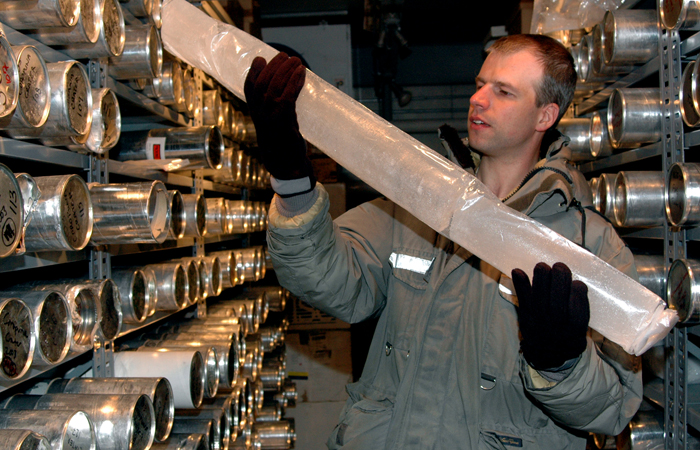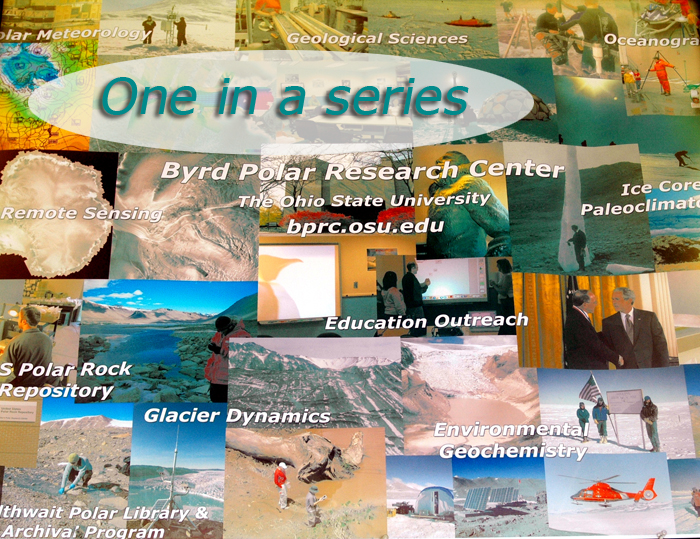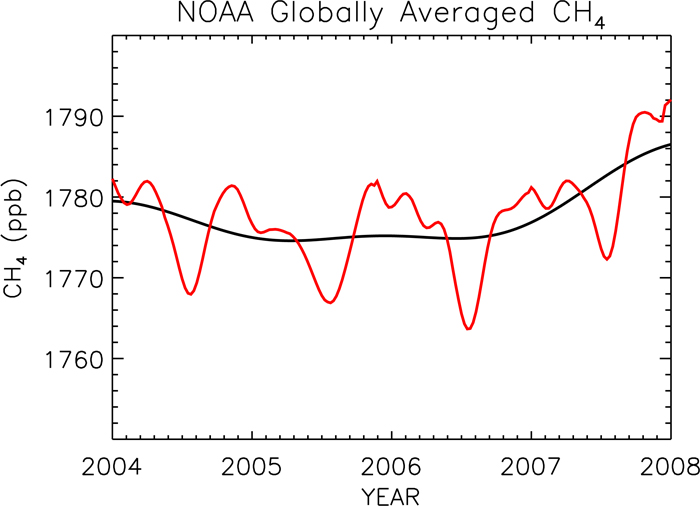|
Without a traceMiniscule metals in ice cores reveal past environmental conditions, pollutionPosted July 11, 2008
Ice cores contain a wealth of information about past climate and environmental conditions, with clues in the form of trapped bubbles of gas and varying concentrations of chemical species and insoluble dust. Paolo Gabrielli wants to improve that history by studying miniscule amounts of metals carried to the ice mainly by dust, what scientists call ultra-trace elements. It’s a bit like looking for the proverbial needle in the haystack. We’re talking something on the order of even less than one part per trillion. (In comparison, scientists talk about concentrations of atmospheric carbon dioxide in parts per million.) The trace elements are present in such a low amount that it is necessary to adopt exceptionally clean sample procedures and a special technique of mass spectrometry for their reliable detection called — take a breath — inductively coupled plasma sector field mass spectrometry. “Trace elements can provide interesting information, such as evidence for past volcanic eruptions and the influx of extraterrestrial particles but they also reveal the current anthropogenic contamination of the atmosphere,” Gabrielli explained. One of the newest members of the ice core paleoclimatology team at The Ohio State University’s Byrd Polar Research Center Scientists already find and study contaminants like lead and mercury in polar ice cores. But they don’t know the spatial extent of the contamination, according to Gabrielli. He is particularly interested in detecting a group of metals known as the platinum group elements — ruthenium, rhodium, palladium, osmium, iridium and platinum. A nifty invention called the catalytic converter on automobiles has helped curb toxic emissions for more than 30 years. But it turns out the converter also releases contaminants of its own into the environment, particularly platinum, palladium and rhodium. “They are clearly detectable in urban environments,” Gabrielli noted. “We want to determine if we can see evidence of this contamination at high altitude sites in the tropics and subtropics … This is important because in this way we could monitor the degree of dispersion of this contamination, and evaluate if this could eventually affect the environment.” Gabrielli and Mosley-Thompson have made it their mission to secure a mass spectrometer for this groundbreaking research, putting in a proposal to the National Science Foundation for the equipment. Mosley-Thompson said only a handful of institutions have mass spectrometers for trace and ultra-trace element work, such as the one at the Desert Research Institute (DRI) overseen by Joseph McConnell. DRI’s ultra-trace ice core analytical laboratory can simultaneously measure a variety of elements in quantities as low as parts per trillion and at very high-depth resolution. “Paolo and the group in Italy where he was trained are the only people who, right now, have developed this technique … to achieve detection at concentrations that are two orders of magnitude smaller than what others can attain” Mosley-Thompson said. “Being able to make those types of measurements is critical for the polar cores [that I study] because the concentrations are already low. Being able to make those measurements allows you to look at many more chemical species than you could before.” An epic ice coreGabrielli’s credentials also involve fieldwork in the Alps and Antarctica, including the high-profile European Project for Ice Coring in Antarctica (EPICA) The EPICA ice core has provided information about past temperature and precipitation rates, atmospheric aerosol composition, solar activity, the flux of extraterrestrial dust onto the Earth, as well as atmospheric greenhouse gas concentrations. The results show, so far, that concentrations of the greenhouse gases carbon dioxide, methane and nitrous oxide have never been as high over the last 800,000 years as today. For instance, data from the core identified the most important processes responsible for changes in natural methane concentrations. An April paper in the journal Nature reported that wetland regions emitted significantly less methane during glacial times. Methane is the second most significant greenhouse gas. Its concentration would swing widely between glacial and interglacial periods, based on data from EPICA. In general, a glacial period involves colder temperatures and advancing glaciers, while interglacials, such as the current Holocene, are periods of warmer temperatures and less ice. During an ice age, the climate alternates between glacial stages and interglacials as Earth’s ice cover waxes and wanes. Methane (CH4) concentrations have ranged from 350 parts per billion to 700 ppbv during the last glacial/interglacial transition. Today, methane emissions, enhanced by human activities, have resulted in concentrations as high as about 1,800 ppbv. Concentrations of this greenhouse gas leveled off over the last decade, but the National Oceanographic and Atmospheric Administration (NOAA) A molecule of methane is 25 times more potent as a greenhouse gas than a molecule of carbon dioxide, but there’s far less of it in the atmosphere. When related climate effects are taken into account, methane’s overall climate impact is nearly half that of carbon dioxide. The EPICA core, which goes back about 800,000 years, also revealed eight previous glacial cycles. An interglacial period about 400,000 years ago shares some characteristics with today’s Holocene, which began about 11,500 years ago. The past interglacial lasted about 28,000 years — without any human influences. “That interglacial period could be the best counterpart of the current one,” Gabrielli said. “It could be a sort of analogue. It is not easy to find a perfect analogue in the past that could explain better how the Holocene period would develop without the anthropogenic influences of the atmospheric greenhouse gas concentrations. “I believe most of the interesting [discoveries from EPICA] are still to come,” he added.
|



For USAP Participants |
For The Public |
For Researchers and EducatorsContact UsU.S. National Science FoundationOffice of Polar Programs Geosciences Directorate 2415 Eisenhower Avenue, Suite W7100 Alexandria, VA 22314 Sign up for the NSF Office of Polar Programs newsletter and events. Feedback Form |




